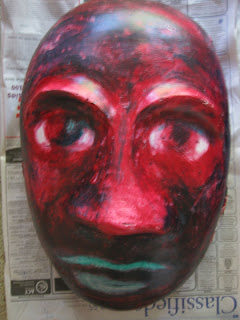I bought a large sheet of copper and got it cut into 15cm/21cm pieces. I wanted eight images and drew and painted about 40 different images and versions of the images from which I eventually chose the eight that I have selected so far.
After settling on the images I then had to work on drawing them to make them fit meaningfully into the size and format that I had chosen for these prints.
I bought bitumen and ferric chloride crystals so that I could prepare and etch the copper plates at home. I read about Paula Rego's prints and found that she paints on the bitumen paint with white gouache before etching. This sounded like a good idea and I found it a very good way of setting the image onto the copper plates before I started with the scratching tool. The black plates with the white drawings on them looked quite good!
Above you can see the plates with the white gouache on them, and one of the plates which has subsequently been drawn into the with tool that draws into the bitumen.
 |
| the drawing tool and the white ground on the bitumen paint |
Once I had made the solution I diluted it 1:1 with water and did a test run on the copper plate which I'd used in the original workshop. I covered the previous image with contact plastic and used the other side of the plate. I tested the etching solution from 5 - 50 minutes at 5 minute intervals. I found that there was no appreciable difference in the amount of etch past 25 minutes of immersion in the solution. I wanted the plates to be evenly etched, so 25 minutes it was.
I etched all of the plates, cleaned off the bitumen with turps and then had the fun job of bevelling and smoothing the edges of the plates. This reduces the risk of the edges of the copper cutting the paper when you are printing and also reduces the amount of unintentional 'border' line around the image being printed.
















